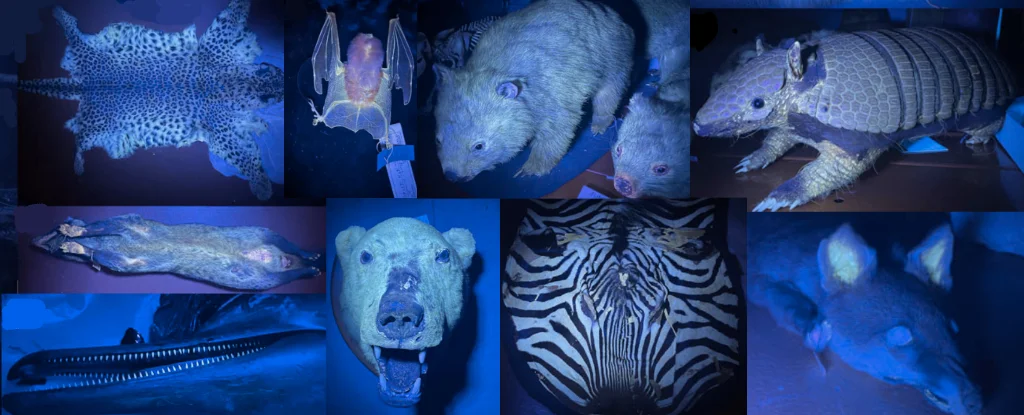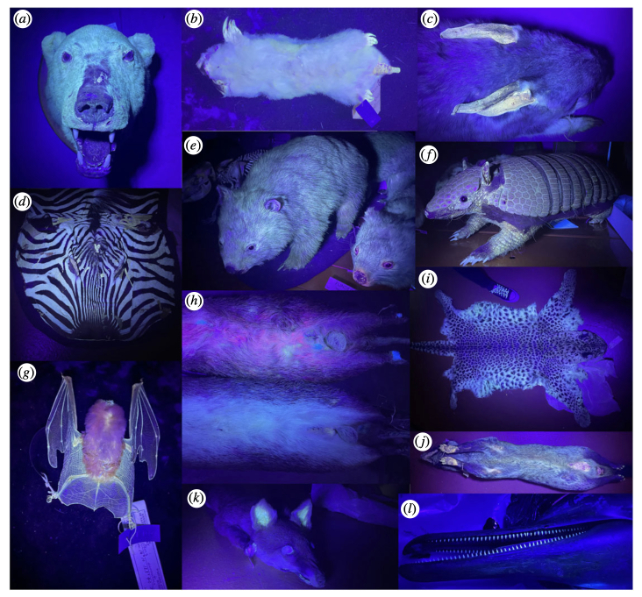Scientists discover 125 new species of fluorescent mammals
- October 5, 2023
- 0
If you were to host a black light party in the taxidermy section of a natural history museum, most of the mammals would fit in there, thanks to
If you were to host a black light party in the taxidermy section of a natural history museum, most of the mammals would fit in there, thanks to

If you were to host a black light party in the taxidermy section of a natural history museum, most of the mammals would fit in there, thanks to their eerie fluorescent glow. That’s what Kenny Travouillon, curator of mammalogy at the Western Australian Museum, discovered when his team exposed 125 mammal species in the collection to ultraviolet light.
The light effect was not limited to platypuses and wombats, which were identified as biofluorescent species a few years ago. Every mammal species they studied emitted a green, blue, pink or white hue under ultraviolet light.
The study found that fluorescence is present in half of mammalian families, in nearly all clades, and in all 27 orders.
“We found that fluorescence is widespread across mammalian taxa,” the researchers write. “The fluorescent areas included white and light-colored fur, feathers, whiskers, claws, teeth, and some exposed skin.”
The only mammal species that did not exhibit external fluorescence was the pygmy spinner dolphin; only his teeth were fluorescent.

Fluorescence occurs when a chemical, such as a protein, absorbs ultraviolet light and then emits longer wavelength light. It has been observed in corals, sea turtles, frogs, scorpions, New World flying squirrels, parrots, rabbits, humans and dormouse. Biologists have long debated whether this fluorescent glow provides an evolutionary advantage or is simply a byproduct of surface chemistry.
“It remains unclear whether fluorescence has any specific biological role for mammals,” the researchers write.
A protein called keratin, found in nails, skin, teeth, bones, feathers, whiskers, and claws, is biofluorescent, but this optical property may just be an accident of evolution. Keratin also causes unpigmented or pale hair to fluoresce.
Southern marsupial mole (Notoryctes typlops) was one of the brightest mammals due to its yellow and white fur. However, this species lives underground.
keratin in fur N. typhlops can be elevated to protect against corrosive soil particles, with fluorescence occurring as a side effect. researchers assume. Similarly, fluorescence seems unlikely to contribute to survival in bats that use echolocation rather than vision for navigation and hunting.
Despite many doubts, there was some evidence that fluorescence was evolutionarily advantageous for some mammals. When researchers saw fluorescence in pigmented fur, they suggested that this effect was caused by a chemical other than keratin, such as fluorophores.
Mammals that are most active at night, dusk, or dawn may use fluorescence to become more visible in low-light conditions for mating or territorial defense.
“Fluorescence was most prevalent and intense in nocturnal species,” the team writes. Platypuses close their eyes underwater to hunt, so their shiny belly fur is unlikely to be a useful visual signal.
But it may also be a form of camouflage called countershading, which is seen in many aquatic animals. Or perhaps the platypus absorbs UV light rather than reflecting it to hide from predators and prey, whose eyes can detect this wavelength of light.
Evolutionary advantage or not, this is a fascinating phenomenon!
Source: Port Altele
As an experienced journalist and author, Mary has been reporting on the latest news and trends for over 5 years. With a passion for uncovering the stories behind the headlines, Mary has earned a reputation as a trusted voice in the world of journalism. Her writing style is insightful, engaging and thought-provoking, as she takes a deep dive into the most pressing issues of our time.